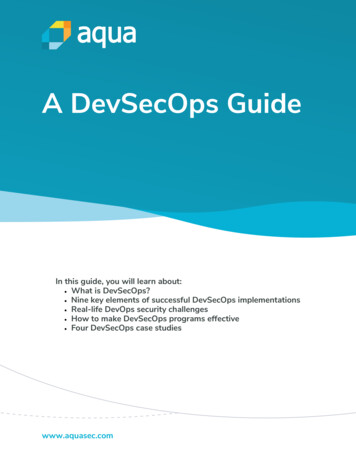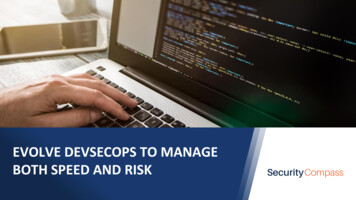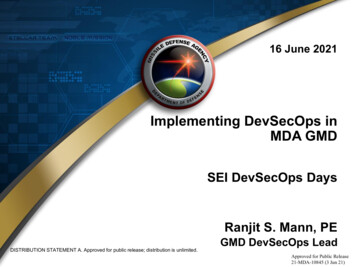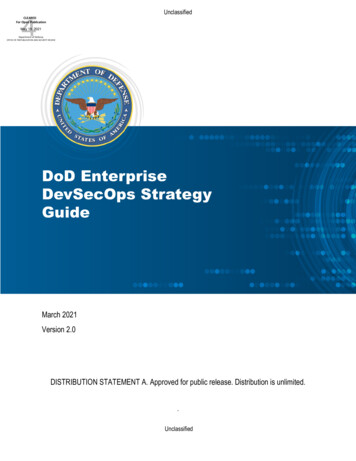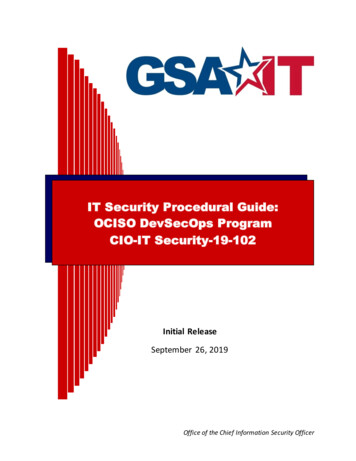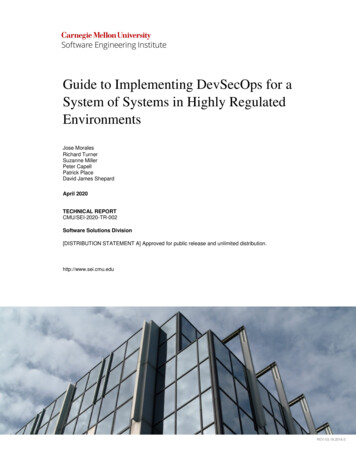
Transcription
Guide to Implementing DevSecOps for aSystem of Systems in Highly RegulatedEnvironmentsJose MoralesRichard TurnerSuzanne MillerPeter CapellPatrick PlaceDavid James ShepardApril 2020TECHNICAL REPORTCMU/SEI-2020-TR-002Software Solutions Division[DISTRIBUTION STATEMENT A] Approved for public release and unlimited 0
Copyright 2020 Carnegie Mellon University.This material is based upon work funded and supported by the Department of Defense under ContractNo. FA8702-15-D-0002 with Carnegie Mellon University for the operation of the Software Engineering Institute, a federally funded research and development center.The view, opinions, and/or findings contained in this material are those of the author(s) and should notbe construed as an official Government position, policy, or decision, unless designated by other documentation.This report was prepared for the SEI Administrative Agent AFLCMC/AZS 5 Eglin Street HanscomAFB, MA 01731-2100NO WARRANTY. THIS CARNEGIE MELLON UNIVERSITY AND SOFTWARE ENGINEERINGINSTITUTE MATERIAL IS FURNISHED ON AN "AS-IS" BASIS. CARNEGIE MELLONUNIVERSITY MAKES NO WARRANTIES OF ANY KIND, EITHER EXPRESSED OR IMPLIED,AS TO ANY MATTER INCLUDING, BUT NOT LIMITED TO, WARRANTY OF FITNESS FORPURPOSE OR MERCHANTABILITY, EXCLUSIVITY, OR RESULTS OBTAINED FROM USEOF THE MATERIAL. CARNEGIE MELLON UNIVERSITY DOES NOT MAKE ANYWARRANTY OF ANY KIND WITH RESPECT TO FREEDOM FROM PATENT, TRADEMARK,OR COPYRIGHT INFRINGEMENT.[DISTRIBUTION STATEMENT A] This material has been approved for public release and unlimiteddistribution. Please see Copyright notice for non-US Government use and distribution.Internal use:* Permission to reproduce this material and to prepare derivative works from this materialfor internal use is granted, provided the copyright and “No Warranty” statements are included with allreproductions and derivative works.External use:* This material may be reproduced in its entirety, without modification, and freely distributed in written or electronic form without requesting formal permission. Permission is required for anyother external and/or commercial use. Requests for permission should be directed to the Software Engineering Institute at permission@sei.cmu.edu.* These restrictions do not apply to U.S. government entities.DM20-0258CMU/SEI-2020-TR-002 SOFTWARE ENGINEERING INSTITUTE CARNEGIE MELLON UNIVERSITY[DISTRIBUTION STATEMENT A] Approved for public release and unlimited distribution.i
Table of ContentsExecutive SummaryAbstractviviii1Introduction1.1 Using the Guide1.2 Scope2The DSO Concept2.1 DSO Principles2.1.1 Collaboration2.1.2 Infrastructure as Code (IaC)2.1.3 Continuous Integration2.1.4 Continuous Delivery2.1.5 Continuous Deployment2.1.6 Environment Parity2.1.7 Automation2.1.8 Monitoring2.2 DevOps Pipelines2.3 HREs and DSO Security2.3.1 HRE Challenges2.3.2 HRE Considerations2.4 SoS and DSO2.4.1 Types of SoS2.4.2 SoS Considerations2.4.3 SoS Integrated Testing44445677788101111131314143Adoption Overview184Prepare for Adoption4.1 Objective: Establish Your Vision4.1.1 Activity: Identify/Build Your Vision4.2 Objective: Determine Readiness to Adopt DSO4.2.1 Activity: Understand Your Context4.2.2 Activity: Implement the Readiness and Fit Analysis Process4.3 Objective: Develop an Adoption/Transition Strategy4.3.1 Activity: Identify Your DSO Adoption Goal(s)4.3.2 Activity: Establish the Initial Adoption Scope4.3.3 Activity: Propose Change (Transition) Mechanisms4.3.4 Example: JIDO DSO Strategy Summary4.4 Objective: Plan Your Next Adoption Activities4.4.1 Activity: Identify Resources4.4.2 Activity: Develop a Backlog and Initial Increment Map4.4.3 Activity: Develop a Communications Plan2020212223293030333435363637375Establishing the DSO Ecosystem5.1 Objective: Change the Culture5.1.1 Activity: Monitor Cultural Change Progress5.1.2 Activity: Influence Change5.2 Objective: Build a DSO Pipeline3939404141CMU/SEI-2020-TR-002 SOFTWARE ENGINEERING INSTITUTE CARNEGIE MELLON UNIVERSITY[DISTRIBUTION STATEMENT A] Approved for public release and unlimited distribution.123ii
5.35.2.1 Activity: Consolidate Pipeline Requirements5.2.2 Activity: Identify and Acquire Needed Components5.2.3 Activity: Install and Launch the Pipeline5.2.4 Activity: Test the Pipeline5.2.5 Activity: Reassess Your DSO PostureObjective: Conduct Trial Use5.3.1 Activity: Select Pilot Tasks/Projects/Work5.3.2 Activity: Conduct Pilot Tasks/Projects/Work5.3.3 Activity: Reassess Your DevOps Posture4446495052535355566Manage and Evolve the Ecosystem6.1 Objective: Monitor the Ecosystem6.1.1 Activity: Establish a Measurement Program6.1.2 Activity: Regularly Reassess Your DSO Technical and Cultural Posture6.2 Objective: Extend DSO (Institutionalize)6.2.1 Activity: Establish Formalization Goals6.2.2 Activity: Document and Train Personnel575758606161627Concepts, Principles, and Tools7.1 Technology Adoption and Culture Change7.1.1 Difficulty of Change7.1.2 A Change Model (Satir)7.1.3 Adoption Commitment Curve (Patterson-Conner)7.1.4 Finding/Selecting Pilot Projects7.1.5 Adopter Analysis7.2 Lean and Agile7.2.1 Principles7.3 Systems Engineering7.3.1 Architecture7.4 Value Stream and Network Visualizations7.5 Policy64646465676868707174757778Appendix A: Collected Activity Summaries80Appendix B: Additional SEI DSO Resources92References98CMU/SEI-2020-TR-002 SOFTWARE ENGINEERING INSTITUTE CARNEGIE MELLON UNIVERSITY[DISTRIBUTION STATEMENT A] Approved for public release and unlimited distribution.iii
List of FiguresFigure 1:Structure of the Implementation Objectives and ActivitiesviFigure 2:DSO Dimensions1Figure 3:Full Stakeholder Engagement in SDLC5Figure 4:Scripting Environment Application for IaC5Figure 5:Automation in DevOps7Figure 6:Communication Between the Development Pipeline and the SDLC9Figure 7:DevSecOps Overview (The Software Factory)Figure 8:A Vehicle as an Embedded SoS view/)15Figure 9:A Corporate IT Infrastructure as a System of Systems16Figure 10:DSO Adoption Overview18Figure 11:Overview of Preparing for Adoption20Figure 12:Difficulty of Change (Adapted from Adler and Shenhar [Adler 1990])23Figure 13:Overview of Establishing the Ecosystem39Figure 14:Connectivity Layout of DSO Pipeline Components46Figure 15:Overview of Manage and Evolve the Ecosystem57Figure 16:Monitoring System Architecture58Figure 17:Difficulty of Change (Adapted from Adler [Adler 1990])64Figure 18:Graphical Summary of the Satir Change Model (Adapted from Weinberg)66Figure 19:Patterson-Conner Adoption Commitment Curve (Adapted from Patterson and Conner)67Figure 20:Satir Model Integrated Into the Adoption Commitment Curve [Miller 2006]68Figure 21:Scrum—Most Commonly Used Agile70Figure 22:Deployability Architecture Tactics Tree76Figure 23:Example of a Value Network77Figure 24:Adaptive Acquisition Framework (https://aaf.dau.edu/aaf/)78CMU/SEI-2020-TR-002 SOFTWARE ENGINEERING INSTITUTE CARNEGIE MELLON UNIVERSITY[DISTRIBUTION STATEMENT A] Approved for public release and unlimited distribution.12iv
List of TablesTable 1:Key for the Activity Summaries19Table 2:Roles, Responsibilities, and Pipeline Interactions27Table 3:Readiness and Fit Analysis Assumptions for DevSecOps30Table 4:Typical Transmission Mechanisms by Adoption Commitment Curve Stages [Adler 1990] 34Table 5:Communication Plan in Tabular Form [Miller 2006]38Table 6:Common Components of a DSO Pipeline42Table 7:Characteristics of a Well-Designed Pipeline43Table 8:Rogers and Moore Adopter Categories [Rogers 2003, Moore 2002]69Table 9:Fundamental Differences Between Traditional and LADSO SE Environments (Adaptedfrom Wrubel 2014)74CMU/SEI-2020-TR-002 SOFTWARE ENGINEERING INSTITUTE CARNEGIE MELLON UNIVERSITY[DISTRIBUTION STATEMENT A] Approved for public release and unlimited distribution.v
Executive SummaryThis document provides guidance for implementing DevSecOps (DSO) in defense or other highlyregulated environments, including systems of systems. It provides information about DSO, itsprinciples, operations, and expected benefits. It describes objectives and activities that are neededto implement the DSO ecosystem, including adopting the culture, deploying technology, andadapting processes.Section 1 introduces the rationale for adopting DevSecOps, the dimensions of change required forthat adoption, and the scope of this document.Section 2 defines the DSO concept, key principles, and its operation. Special DSO concerns raisedin high-risk environments (HREs) and SoS environments are also addressed.Section 3 is an overview of the adoption guidance.Sections 4-6 describe the activities for adopting DSO. The core of the guide, they address threemajor efforts: Preparation, Establishment, and Management. Preparation is necessary to create achievable goals and expectations and to establish feasibleincrements for building the ecosystem. This includes considering the distance between whereyou are and where you want to be, and understanding the effort necessary to travel that path. Establishing the ecosystem includes evolving the culture, automation, processes, and systemarchitecture from their initial state toward an initial capability. Managing the ecosystem includes measuring and monitoring both the health of the ecosystemand the performance of the organization. The intent is to evolve the ecosystem toward a desired state in a manner that balances speed with depth, minimizes unnecessary rework, andconstantly revalidates and adapts the desired state.Prepare for AdoptionEstablish the EcosystemBuild a DSO PipelineEstablish yourvisionTrial useDeterminereadiness to adoptDevelop adoptionstrategyPlan initialadoption activitiesFigure 1:Change the cultureManage and Evolve the EcosystemMonitor the ecosystemPlan ongoing adoption activitiesExtend DSOStructure of the Implementation Objectives and Activities Appendix A is a collection of the activity summaries. Appendix B contains references on technical subjects, change management approaches, andmore advanced DSO information and guidance.CMU/SEI-2020-TR-002 SOFTWARE ENGINEERING INSTITUTE CARNEGIE MELLON UNIVERSITY[DISTRIBUTION STATEMENT A] Approved for public release and unlimited distribution.vi
As illustrated, activities are not necessarily sequential—some are dependent on other activities,and some may be done simultaneously. The descriptions are general enough to support adaptationto varied environments.Section 7 is a compendium of information on the concepts and principles that provide the foundation for DSO adoption—Technology Adoption, Culture Change, Lean and Agile, Systems Engineering, and others—to introduce the concepts and show how they relate to DSO success.CMU/SEI-2020-TR-002 SOFTWARE ENGINEERING INSTITUTE CARNEGIE MELLON UNIVERSITY[DISTRIBUTION STATEMENT A] Approved for public release and unlimited distribution.vii
AbstractDevSecOps (DSO) is an approach that integrates development (Dev), security (Sec), and delivery/operations (Ops) of software systems to reduce the time from need to capability and providecontinuous integration and continuous delivery (CI/CD) with high software quality. The rapid acceptance and demonstrated effectiveness of DSO in software system development have led to proposals for its adoption in more complex projects. This document provides guidance to projects interested in implementing DSO in defense or other highly regulated environments, including thoseinvolving systems of systems.The report provides rationale for adopting DSO and the dimensions of change required for thatadoption. It introduces DSO, its principles, operations, and expected benefits. It describes objectives and activities needed to implement the DSO ecosystem, including preparation, establishment, and management. Preparation is necessary to create achievable goals and expectations andto establish feasible increments for building the ecosystem. Establishing the ecosystem includesevolving the culture, automation, processes, and system architecture from their initial state towardan initial capability. Managing the ecosystem includes measuring and monitoring both the healthof the ecosystem and the performance of the organization. Additional information on the conceptual foundations of the DSO approach is also provided.CMU/SEI-2020-TR-002 SOFTWARE ENGINEERING INSTITUTE CARNEGIE MELLON UNIVERSITY[DISTRIBUTION STATEMENT A] Approved for public release and unlimited distribution.viii
1 IntroductionYour team of developers will soon start a new software project. The project goal is the creation ofa new capability that involves developing several systems dependent on each other to function appropriately, in other words, a system of systems (SoS). Some software or hardware used by theSoS is of a sensitive nature requiring development and testing in closed areas with high security—a high-risk environment (HRE). Your organization has decided to adopt DevSecOps (DSO) andrequires your team of developers to use it for this project. In this document, we will help you implement DSO in an HRE for the development of an SoS.DSO is a socio-technical system that integrates development, security, and operations in supportof a continuous integration, continuous delivery (CI/CD) environment. DSO promises a high return on investment but requires a significant shift in existing culture, process, and technology. TheDSO environment is specifically designed to increase system quality, reduce capability time-tovalue, and minimize cognitive differences among the developers, securers, operators, and users ofmission-critical defense and intelligence community systems.Substantively changing even one of those things in an established organization is difficult. Theimpact of changing them all may seem impossible, but it has been done with significant success[CircleCI 2019]. Clearly, moving your organization down a path to DSO without compromisingyour existing mission goals and strategic trajectories is a daunting task—one that is different forevery organization.As shown in Figure 2, tools and practices are not the only consideration in DSO; successful adoption must navigate four interrelated dimensions of change.Culture—DSO integrates activities of peoplewith different mental models and responsibilities; this impacts the way the organization communicates and works together. DSO is a noblame culture. “Blame-processing” wastes timeand energy; the focus of DSO is on identifying,fixing, and preventing the problem from recurring. DSO culture is transparent; Lean and Agile practices require sharing information to makedecisions at the lowest level and orchestrate theoverall flow. DSO culture is efficient, constantlyeliminating limited-value work. DSO is integrated, reducing silos and incorporating all ofthe disciplines (e.g., development, verificationand validation/Quality Assurance, operations,users, managers, finance, procurement) in the team.Figure 2:DSO DimensionsProcesses and Practices—DSO requires processes that support the culture and integrate the development and operations work. Organizational changes will likely be needed. OrganizationalCMU/SEI-2020-TR-002 SOFTWARE ENGINEERING INSTITUTE CARNEGIE MELLON UNIVERSITY[DISTRIBUTION STATEMENT A] Approved for public release and unlimited distribution.1
structures, work descriptions, responsibilities, reward systems/incentives, VV&A processes, procurement/licensing practices, decision making, and feedback mechanisms are examples of theDSO scope.System and Architecture—DSO works most efficiently if the target system is architected to support the DSO practices. The architecture should support test automation and continuous integration goals; applications should support changes without release (e.g., late binding) and ensure therequired -ilities (e.g., scalability, security, reliability).Automation & Measures—While DSO is primarily about culture, people, and processes, automation is a primary enabler for achieving its benefits. DSO seeks to automate repetitive and errorprone tasks (e.g., build, testing, deployment, maintaining consistent environments), provide staticanalysis automation (for architecture health), and enhance communications and transparencythrough performance dashboards and other radiators.1.1 Using the GuideThis guide was written to lead you through the activities to implement DSO practices and evolveyour organization to provide the desired benefits.Adopting a technology like DSO is like any other project—it needs a set of goals and measures, amanagement process, an adoption team to lead the transition, participation from the technicalstakeholders that will use and benefit from the project, and the support and funding of the organization. The guide provides the information necessary to capture/create all of these and manage asuccessful adoption.The guide is organized as follows: This Introduction describes the scope of the provided adoption guidance. Section 2 introduces the DevSecOps concept and describes how information flows though theDSO-enabled organization. Section 3 provides an overview of the adoption process. Sections 4-6 describe the activities for adopting DSO. This is the “meat” of the guide andcomprises three major efforts: Preparation, Establishment, and Management. Section 7 is a compendium of information about the concepts and principles associated with approaches that provide the foundation for DSO adoption—change management, Lean and Agile,DevOps, systems engineering, architecture, and policy. This section is provided to introduce the concepts and show how they relate to DSO success. Appendix A is a collection of the activity summaries. Appendix B contains references on technical subjects, change management approaches, andmore advanced DSO information and guidance.CMU/SEI-2020-TR-002 SOFTWARE ENGINEERING INSTITUTE CARNEGIE MELLON UNIVERSITY[DISTRIBUTION STATEMENT A] Approved for public release and unlimited distribution.2
1.2 ScopeThis guide is intended specifically for adopting DSO infrastructure to support systems development in HREs and is based on Implementing DevOps Practices in Highly Regulated Environments[Morales 2018]. An HRE is enforced when some system software or hardware is of a sensitive nature, requiring development and testing in closed areas with high security. It addresses the creation and operation of a single, dedicated pipeline architecture that can be adopted and scaled tosupport multiple products.The guide also suggests ways for the development team to address SoS issues. These issues arisein DSO operations when the software developed supports external functionality and needs to integrate, test, and receive feedback from systems outside software development boundaries.Both of these topics are addressed more fully in Section 2.CMU/SEI-2020-TR-002 SOFTWARE ENGINEERING INSTITUTE CARNEGIE MELLON UNIVERSITY[DISTRIBUTION STATEMENT A] Approved for public release and unlimited distribution.3
2 The DSO ConceptDSO integrates software development and operational process security activities into the DevOpsapproach. It focuses on assuring security best practice is enforced at each step. For cyber-physicalsystems, DSO is a set of principles and practices emphasizing collaboration and communicationamong staff from engineering, hardware/software (HW/SW) design, development, integration andtest, acquisition, security, services, end users, and any other stakeholders key to delivery of a secure software-intensive HW/SW system.2.1 DSO PrinciplesDSO principles are based on the Lean and Agile principles, whose foundational concepts are addressed in Section 7, and DevOps principles [Kim 2016]. These principles are broadened to integrate development, security, and operations activities into a continuous integration/continuous deployment (CI/CD) pipeline. While several versions of these principles exist, the SoftwareEngineering Institute (SEI) articulates them in Sections 2.1.1-2.1.8.2.1.1CollaborationFull stakeholder engagement in every aspect of the software development lifecycle (SDLC), illustrated in Figure 3, facilitates full awareness and input on all decisions and outcomes. Developers,operators, engineers, end users, customers, and other relevant stakeholders are allowed to be partof decision making and work progress. This allows transition from development to operations tooccur with fewer or no blockers.2.1.2Infrastructure as Code (IaC)IaC is code written to build infrastructure. IaC is a core principle of DSO. The code specifiesneeded components and the details of how each should be installed. The medium where this infrastructure will be installed and executed can be specified in the code or at build time. The mediumcan be actual or virtualized hardware or a mix of both. Infrastructure is not limited—it can be thesoftware of a single, end-user machine or an entire organization’s enterprise. Software components such as operating systems, servers, and applications are typically specified in IaC. Hardwarecomponents such as storage, CPU, memory, and network topology are also specified. For moreinformation, see Infrastructure as Code: Final Report [Klein and Reynolds 2019].CMU/SEI-2020-TR-002 SOFTWARE ENGINEERING INSTITUTE CARNEGIE MELLON UNIVERSITY[DISTRIBUTION STATEMENT A] Approved for public release and unlimited distribution.4
Figure 3:Full Stakeholder Engagement in SDLCFigure 4:Scripting Environment Application for IaCFrom a DevOps perspective, the IaC code is usually a companion to software requiring this infrastructure to execute They are stored together in a version-controlled repository and used by somemechanisms, typically a build server, to produce the needed infrastructure with the software capable of running on it. Using version control guarantees standardization and reproducibility fromsource code; these further allow environment parity (identical or highly similar environments) ofinfrastructure and automated building. The ability to dynamically build a fully functioning infrastructure, as shown in Figure 4, sustains the velocity of integration while assuring environmentparity in development, staging, and production. More information on IaC can be found in Infrastructure as Code: Final Report [Klein and Reynolds 2019].2.1.3Continuous IntegrationCI is the unification of individual components into one entity. Unification occurs on a regular basis. The components, once unified, are meant to function together as a whole. The componentsmay have dependencies on one another to function properly. CI is a core principle of DSO and isoften referenced together with CI/CD, which we discuss in the next sections.CMU/SEI-2020-TR-002 SOFTWARE ENGINEERING INSTITUTE CARNEGIE MELLON UNIVERSITY[DISTRIBUTION STATEMENT A] Approved for public release and unlimited distribution.5
In DevOps, CI occurs at three specific phases in the pipeline.1.The first phase is source code CI. This occurs in the version-controlled repository. Individualdevelopers push their code to their personal branch in a repository. The repository pulls allthe code from all personal branches into one unified master branch. The master branch is theculmination of the first phase. With this master branch, all forms of static analysis and testing should be performed. Tests should include a focus on security, needed dependencies, andprogram logic. Once all tests pass, the master branch can be cloned into a release branch. Anew release branch should be created each time the master branch is updated and passes alltests.2.The second phase is deployable component CI. This is typically carried out by the buildserver. The server pulls code from all master branches along with IaC and dependencies.These are all combined, creating a unified component placed on a deployable medium. Thecomponent represents the executable form of all the pulled source code installed within theinfrastructure needed to successfully run. With this component, all forms of dynamic analysis and testing should be performed. The tests should include a focus on proper execution,security, expected input, output, and results.3.The third phase is capability CI. This occurs in the staging environment. All deployable artifacts from multiple development teams are unified within one staging environment. The environment represents the current state of the capability being developed for a given project.The current state is measured by the portions of the capability, housed in deployable components, currently present in the staging environment. With this staging environment, dynamicanalysis and testing should be performed. The tests should include a focus on integration andsecurity. Integration testing should ensure that newly added components function as expected without disrupting the execution of other components.At the beginning of the pipeline, a developer must manually push their completed source code totheir personal branch in the version-controlled repository. This is usually referred to as a commitoperation. The CI steps taken from personal branches to the staging environment can be fully automated. The automation includes all testing. The whole automation process is dependent on theinitial, manual step of developers pushing their source code into respective branches. This leads tothe often-stated phrase among developers “commit often.”2.1.4Continuous DeliveryCD is the automated transfer of software to an environment that has parity with the production environment, followed by a manual decision to transfer the software into production. The environment-sharing parity with production is often referred to as the staging environment. CD is the culmination of CI. CD encompasses the last steps of CI and represents the actual act of placingsoftware into staging and production. This critical step is a needed manual decision to transfercode into production. This occurs due to additional tasks the software must complete along withmanual validation of their outcomes before allowing transfer into production. A CI/CD pipelinecan be fully automated up to staging but must pause for the manual decision, allowing a push intoproduction. This is part of the DevOps pipeline, but it slows down at this point due to the need formanual decision making to proceed. This is the dominant form of CI/CD in HREs. In this document, we only refer to this form of CI/CD.CMU/SEI-2020-TR-002 SOFTWARE ENGINEERING INSTITUTE CARNEGIE MELLON UNIVERSITY[DISTRIBUTION STATEMENT A] Approved for public release and unlimited distribution.6
2.1.5Continuous DeploymentCD is the automated transfer of software directly into a production environment. The productionenvironment is typically live and in full operation. In contrast to continuous delivery, there is nomanual decision needed. There is also no staging environment. This form of CD relies on rigorousstatic testing of source code and dynamic testing of deployable artifacts. Very small pieces ofcode are purposely pushed through this pipeline to facilitate rigorous testing. The lack of testingin a staging environment introduces a high risk of defects entering the production environment.This form of CI/CD is rarely used in HREs.2.1.6Environment ParityEnvironment parity occurs when two or more environments are as identical as possible. InDevOps, parity is pursued between staging and production and between development environments. The use of IaC and deployable artifacts is critical to achieving parity. With parity, developers work in identical environments. Parity between staging and production reduces or eliminatespotential problems in the production environment, although integration testing should always beperformed in production.2.1.7AutomationKey to a successful DSO process is the scripted configuration and automation of Build, Automated Testing, and Automated Delivery/Deployment in continuous iterative cycles. Automationis a core principle of DSO. An example of implementing automation with continuous deploymentin DSO is shown in Figure 5.Figure 5:Automation in DevOpsRemoving tasks from developers allows for focused code writing and testing. A single commandissued by a developer pushes code to a version-controlled repository. Another command builds anentire project and the needed platform for execution onto a selected medium. A separateCMU/SEI-2020-TR-002 SOFTWARE ENGINEERING INSTITUTE CARNEGIE MELLON UNIVERSITY[DISTRIBUTION STATEMENT A] Approved for public release and unlimited distribution.7
command commences complete testing with integrated deliveries and deliveries into staging andproduction environments.2.1.8MonitoringContinuous monitoring using a collection of performance metrics simultaneously improves theDSO pipeline and software under development. Monitoring is a core principle of DSO. Improvement occurs by alerting stakeholders when the pipeline falters or the software under developmentfails tests or execution.Examples of where processes falter in the pipeline include incomplete code deliveries, failed teststarts, unresponsive staging environments, unsuccessful builds, and denied pushes to the repository. Examples of failures in software under development are failed unit tests, failed functionaltests, system crashes in staging or production, and unexpected functionality after integration withother software.Automation and continuous cycles of development and test require non-stop monitoring to ensurean optimally functioning pipeline. At the same time, work progress, satisfaction of requirements,and, most importantly, quality are quantified with code execution and testing results. Automatedresolution can occur for some sub-optimal metrics while the balance may require manual intervention.2.2 DevOps PipelinesA pipeline assists all stakeholders in every aspect of software development including building,testing, delivery, and monitoring. For engineers, the main use of a pipeline is to build, test, anddeliver
2.2 DevOps Pipelines 8 2.3 HREs and DSO Security 10 2.3.1 HRE Challenges 11 2.3.2 HRE Considerations 11 2.4 SoS and DSO 13 2.4.1 Types of SoS 13 2.4.2 SoS Considerations 14 2.4.3 SoS Integrated Testing 14 3 Adoption Overview 18 4 Prepare for Adoption 20 4.1 Objective: Establish Your Vision 20

